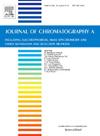Multi–class cyanobacterial toxin analysis using hydrophilic interaction liquid chromatography–mass spectrometry
IF 3.8
2区 化学
Q1 BIOCHEMICAL RESEARCH METHODS
引用次数: 0
Abstract
Cyanobacteria produce diverse classes of toxins including microcystins, nodularins, anatoxins, cylindrospermopsins and saxitoxins, encompassing a range of chemical properties and mechanisms of toxicity. Comprehensive analysis of these toxins in cyanobacterial, environmental and biological samples generally requires multiple methods of extraction and analysis.
In this work, a method was developed for the major classes of cyanotoxins, which comprised of a three-step liquid-solid extraction method using 75 % CH3CN with 0.1 % HCOOH and a hydrophilic interaction liquid chromatography (HILIC) elution gradient that provided retention of the less polar microcystins through to the highly polar saxitoxins. Detection was performed by tandem mass spectrometry in selected reaction monitoring mode with positive and negative polarity switching. Identification criteria included matching retention times and product ion ratios with available standards. In-house validation demonstrated good performance of the method including precision ranging from 1.5 (microcystin-LA) to 5.8 (gonyautoxin-2) % RSDs, and detection limits ranging from 0.01 (cylindrospermopsin) to 0.99 (gonyautoxin-3) µg/g in freeze dried material cyanobacteria. Recovery was assessed using spiked non-toxic cyanobacterial samples (Aphanizomenon sp.) and ranged from 83 (neosaxitoxin) to 107 % ([Dha7]microcystin-LR).
As a demonstration of application, toxin profiles in cyanobacterial cultures, benthic and planktonic cyanobacteria field samples, and shellfish reference materials were successfully evaluated. The procedure is also amenable for extension to other polar toxin classes including domoic acid and guanitoxin. With increasing reports of cyanobacterial blooms globally, the method represents a powerful quantitative screening tool for measuring cyanotoxins across a broad range of samples.
利用亲水相互作用液相色谱-质谱法分析多类蓝藻毒素。
蓝藻产生的毒素种类繁多,包括微囊藻毒素、球藻毒素、锐毒素、圆柱藻毒素和沙西毒素,其化学性质和毒性机制各不相同。要全面分析蓝藻、环境和生物样本中的这些毒素,通常需要多种提取和分析方法。在这项工作中,针对主要类别的蓝藻毒素开发了一种方法,该方法包括三步液固萃取法,使用 75 % CH3CN 和 0.1 % HCOOH 以及亲水作用液相色谱(HILIC)洗脱梯度,可保留极性较低的微囊藻毒素和极性较高的沙西毒素。检测采用串联质谱法,在选择反应监测模式下进行正负极性切换。鉴定标准包括保留时间和产物离子比是否与现有标准相符。内部验证表明该方法性能良好,在冷冻干燥的蓝藻材料中,精确度从 1.5%(微囊藻毒素-LA)到 5.8%(褐藻毒素-2)不等,检测限从 0.01(圆柱孢藻毒素)到 0.99(褐藻毒素-3)微克/克不等。使用添加的无毒蓝藻样本(Aphanizomenon sp.)对回收率进行了评估,回收率从 83%(新沙蚕毒素)到 107%([Dha7]微囊藻毒素-LR)不等。作为应用示范,成功评估了蓝藻培养物、底栖和浮游蓝藻现场样本以及贝类参考材料中的毒素概况。该程序还可扩展到其他极性毒素类别,包括多莫西酸和胍基毒素。随着全球有关蓝藻藻华的报道越来越多,该方法是一种强大的定量筛选工具,可用于测量各种样本中的蓝藻毒素。
本文章由计算机程序翻译,如有差异,请以英文原文为准。
求助全文
约1分钟内获得全文
求助全文
来源期刊

Journal of Chromatography A
化学-分析化学
CiteScore
7.90
自引率
14.60%
发文量
742
审稿时长
45 days
期刊介绍:
The Journal of Chromatography A provides a forum for the publication of original research and critical reviews on all aspects of fundamental and applied separation science. The scope of the journal includes chromatography and related techniques, electromigration techniques (e.g. electrophoresis, electrochromatography), hyphenated and other multi-dimensional techniques, sample preparation, and detection methods such as mass spectrometry. Contributions consist mainly of research papers dealing with the theory of separation methods, instrumental developments and analytical and preparative applications of general interest.
 求助内容:
求助内容: 应助结果提醒方式:
应助结果提醒方式:


